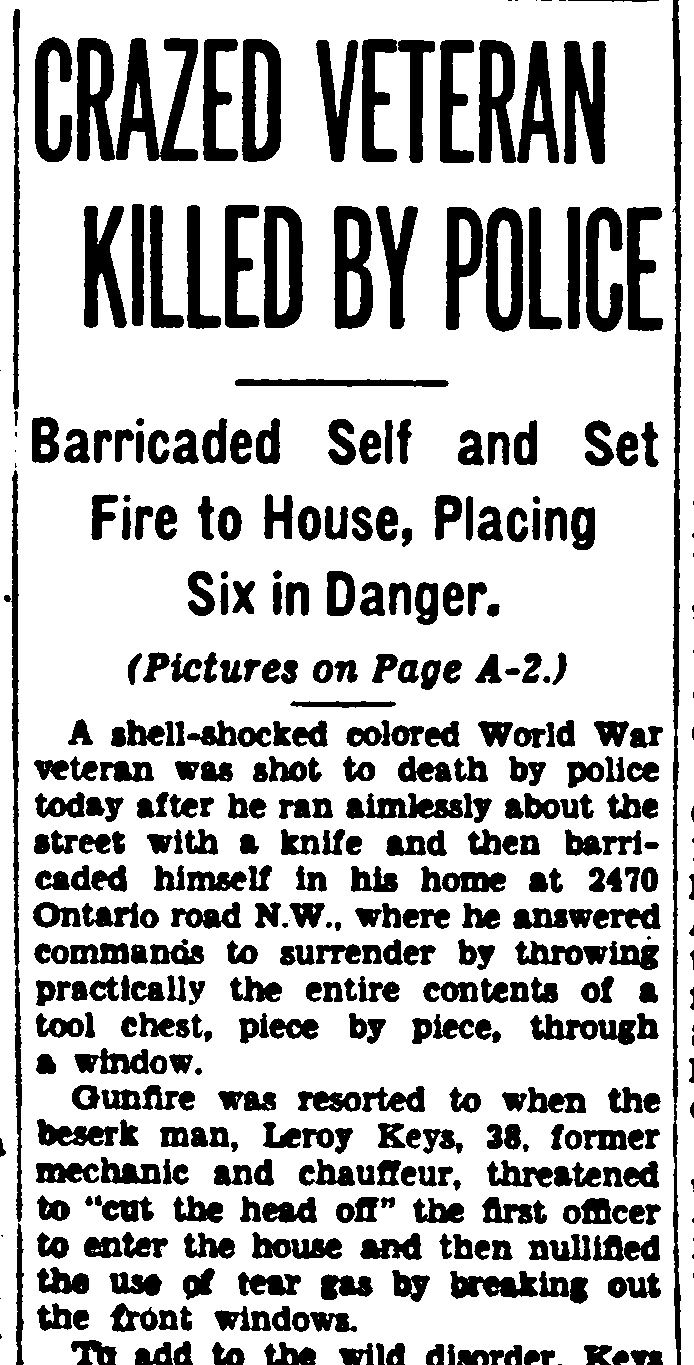
There is little doubt that two of the most important issues within American policing are the treatment of people of color and the treatment of people with mental illnesses. A 2019 study found that out of all groups “black [males] face the highest lifetime risk of being killed by police”, finding that “1 in 1000 black [males] will be killed by police over the life course”. Meanwhile, a 2015 study by the Treatment Advocacy Center found that Americans with “mental illness are 16 times more likely to be killed during a police encounter than other civilians”. While worthy of outrage on their own, these variables have been found to have an even worse effect when combined.

This trend of mentally ill Black men being at great risk of being killed by the police is not new. Take for example the case of Leroy Keys. According to Washington Post contributor John Kelly, on March 8, 1938, District police officers John Nally and Robert Henry responded to a call about a man wielding a knife and found Keys behaving erratically outside his sister’s house. Keys had served in the US Army during World War I and “had returned from the war ‘shell-shocked,’ in the parlance of the time”. Keys was in the midst of a flashback when the officers arrived and, believing them to be German troops, ran into his sister’s home and barricaded himself inside. According to the officers, “Keys set fire to lace curtains in his apartment”, which “prompted them to use their weapons”, shooting Keys three times and killing him. As Kelly points out, contrary to the officers’ account “a next-door neighbor… said the fire was started by the officers’ guns”. Another contradiction with the officers’ narrative is the testimony of Keys’s sister that “she watched as an officer took one of her bread knives and laid it on the living room floor”.
According to Kelly, a coroner’s jury convened the following day to determine whether the officers’ actions were justified. When asked “Why hadn’t police used tear gas to drive Keys from his home?”, the officers explained that because Keys had broken a window tear gas would be ineffective: this is absurd because, as a jury member questioned, “Wasn’t that the same type of gas used in dispersing street mobs in the open?”

This case bears a resemblance to the recent case of Damian Daniels. As reported by the Associated Press, on August 25, 2020, Brendan Daniels contacted the Bexar County Sheriff’s Department to request a mental health check-in on his brother, who suffered from mild PTSD linked to his service as a Sergeant in the US Army deployed to Afghanistan. Brendan had observed that Damian had gone from seeming normal to a state of paranoia in only a matter of days and was now suffering from hallucinations. Deputies John Rodriguez, Enrique Cepeda, and Michelle Garriffa found Daniels standing on his front porch “with a bulge at his waistband from a gun and a pained expression on his face”. According to his brother, Daniels “often carried a handgun — Texas’ loose gun laws were an attraction to the state”. After a half hour of discussion, the deputies attempted to make Daniels to seek mental health treatment against his will, and during the ensuing struggle shot the veteran twice, killing him.
This was not the first time deputies had checked in on Daniels: in fact, it was the fourth time in the past couple days. An official report showed that Daniels “had told deputies one day earlier he was diagnosed as paranoid and had not taken his medications”. Deputies had found Daniels sitting in his lawn, because he was hearing strange noises and suspected his house may be haunted. KENS5 contributor Mariah Medina, goes on, however, to point out that “even with information that Daniels was living with mental illness and had been off his medication, no one from the mental health unit became involved when deputies were dispatched to Daniels' home the next day”.

While certain details of these cases may differ, both incidents involve a Black Army veteran who was suffering a PTSD episode (a flashback for Keys and paranoia for Daniels) but had not hurt or threatened to hurt anyone prior to being approached being shot by police despite the existence of safer alternatives for subduing them (tear gas for Keys and the BCSD mental health unit for Daniels). While the existence of mental health units implies progress in the prevention of police violence against civilians with mental illness, yet the outcome of these two incidents remains the same. These cases are consistent with Camille Nelson’s concept of felonization, in “which a suspect is transformed into a more serious offender deserving of harsher criminal justice responses” (p. 620). This process is relevant because, as Nelson explains, the circumstances under which felonization occurs “are particularly fraught for individuals who are mentally or physically vulnerable, as they may struggle or be unable to comport their behavior to police dictates for obedience and compliance” (p. 620).
John Kelly’s question reflecting on the murder of Leroy Keys is equally applicable to that of Damian Daniels: “Would a white veteran have been shot dead in his own home by the police?”
Comentarios